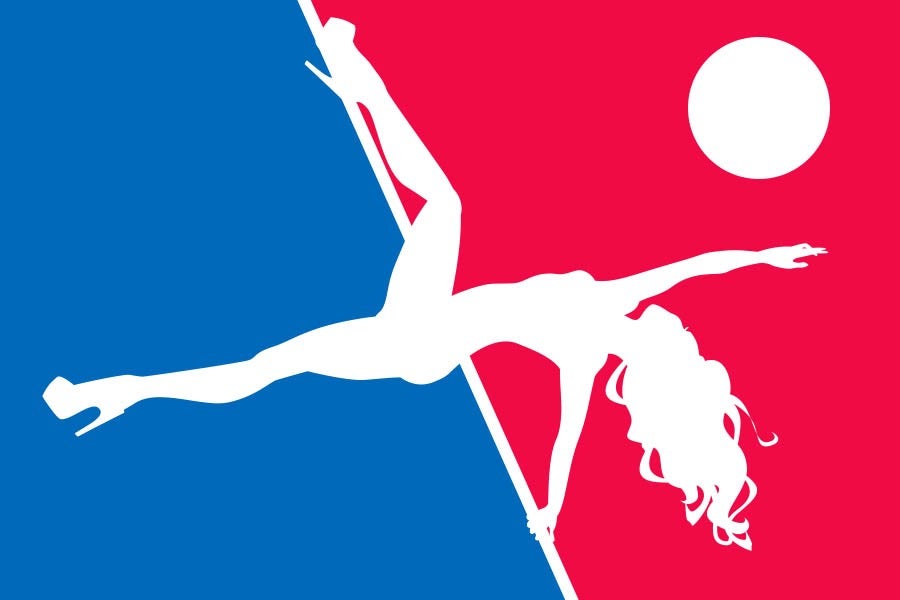Because I’ve been pole-dancing alongside naked women my entire adult life and have been a longtime rabid fan of the art of pole-dancing in general, I was pleased to recently read that pole-dancing is now recognized by the Global Association of International Sports Federation as an actual sport, potentially putting it on track to be an Olympic event.
There are currently 39 disciplines in 26 Olympic sports. Among the most obscure: trampoline, handball and a derivative of dressage called eventing. Pole-dancing, on the other hand, is far from obscure. It’s as American as hot dogs, baseball and rock ’n’ roll. So it’s about time that the GAISF considered it a legit sport.
But will mainstream audiences?
American culture has a long tradition of being uptight about sex and dismissive about strippers. So if pole-dancing becomes an Olympic sport, I wonder if it will be robbed of its essence and the strippers who invented it lost and forgotten. They’re the ones who created pole-dancing as a seductive performance requiring a delicate balance of athlete and angel, shimmering under red lights on a vertical pole for tips.
I first learned to pole-dance in the mid-1990s, when my minimum-wage retail job in San Francisco neither fed me enough nor paid my exorbitant rent. Stripping was considered to be a viable source of income by feminists, artists and queers, so I shaved my head, borrowed a blond wig and clocked in for booty duty between classes at Mills College. I learned elegant pole tricks from the black girls at Market Street Cinema. Dancers twirled in black PVC corsets to Bauhaus and Joy Division or glided in red teddies to Snoop and Lil’ Kim. I learned to whip around the pole like they did with strength, humor and aerodynamic poetry.
When I worked as a featured house girl with a friend, we had three shows per day: 11 a.m., 7 p.m. and 11 p.m. We choreographed our pole-dancing routines with costumes and synchronized pole tricks in fringe, beaded scarves and leather shorts with silver-star patches on our asses. During our routine to classic 1980s rock, I did inversions in heavy white roller skates with electric orange wheels and injured my rotator cuff so badly that I couldn’t carry a small purse or drive my motorcycle for months.
I guess what I’m saying is that to maintain pole-dancing isn’t a legit sport is like suggesting a drum machine isn’t an instrument. Pole-dancing is profundity in flight, and its history has roots in circus arts, burlesque and belly-dancing.
As early as the 1920s, dancers were hired to do the “Hoochie Coochie” around circus poles that supported the traveling big-tent stage. In the 1940s and 1950s, gowned or nude showgirls like Lili St. Cyr performed a seductive nude dance in swanky nightclubs across the country. Other burlesque strippers of St. Cyr’s day used props like parrots, canes and bathtubs for their acts. According to the website Vertical Wise, the first recorded stripper pole was in 1968 at an Oregon strip bar called Mugwump. Within two decades, it was a mainstay in topless bars and go-go clubs everywhere.
Soon thereafter (circa 2000), pole-dancing became a wildly popular fitness craze. Gyms with spinning and free-standing vertical poles popped up as pole-dancing gyms appropriated stripper moves while simultaneously discrediting them — branding pole-dancing as a woman-centered workout while denying any affiliation with the sex workers who started it. Everyday women learned to climb, twerk and glide their Pilates-bodies across a floor as if they, too, were born to strip.
Businesses that cornered the pole-dancing market promised mirrorless studios and a “sacred space” for instructed fitness pole routines that were priced anywhere from $69 for introductory courses to $325 for clusters of classes to thousands more for vague cultish retreats. The rhetoric at some pole studios pressed women to explore their erotic side in an intimate environment without having to shimmy near an actual stripper. This anti-sex worker brand of pole-dancing is yet another way the mainstream seeks to erase sex workers from the cultural fabric while stealing our moves.
But deal with it: Strippers created and first popularized pole-dancing.
Women like Cameron, an unnervingly skinny stripper with a butterfly chest tattoo and dark bangs I worked with at a titty bar in the Coachella Valley. She practiced her pole tricks to warm up and stayed on stage when she was bored and the club was dead. Last week, she was shot in the head — her body found in a parking lot in Palm Springs. I didn’t know Cameron outside the club or what her life was like. I do, however, know her by her music: Rob Zombie, Tool, Danzig. I can still see her pole-dancing to it, her black bikini ties floating behind her like contrails.
That I’ll never forget.
Nor should anyone else.

